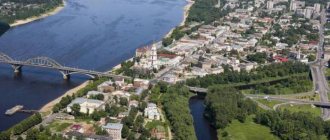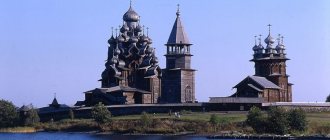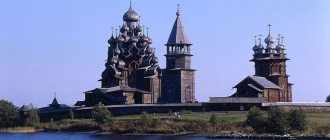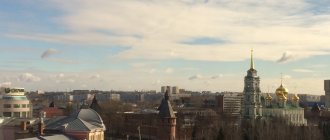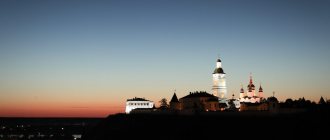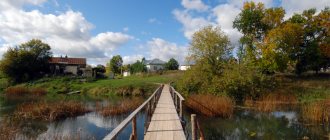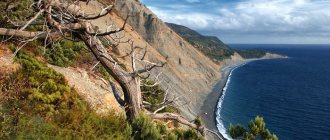Zaraisky Kremlin - This is an ancient Russian fortress located on the banks of the Osetr River in the town of Zaraysk near Moscow, as well as a museum-reserve of the same name operating on its territory.
The Kremlin was built in 1528-1531 by order of Tsar Vasily III. Its territory occupies an area of about 2.5 hectares (in plan it is a rectangle of 190x134 meters), along its perimeter there are powerful fortress walls with 7 towers, three of which have gates (and another gate is broken through the eastern wall). The total length of the walls is 648 meters: the Zaraisky Kremlin is considered the smallest Kremlin in Russia.
Despite its small size, the fortress can boast of an enviable achievement: it is the only completely preserved Kremlin in the Moscow region.
Architectural ensemble
Nowadays, the Zaraisk Kremlin is considered the main historical and cultural complex of Zaraysk and is the most famous landmark of the city. One of the main advantages of the fortress is that its territory is, in fact, a large city park with free access for citizens and tourists.
People come here not only to admire the architecture or visit a museum, but also to simply sit on the grass surrounded by ancient walls or swing on a swing.
Between the buildings preserved on the territory there are convenient pedestrian alleys, along which information signs, lanterns and benches are installed, as well as ornamental plants planted.
Everything looks very well-groomed and tidy, but what’s especially nice is that they managed to find a balance between modern amenities and the historical environment. There is not “too much” improvement that it begins to distract attention from its main point of attraction - the Kremlin itself, and the paved paths do not look something alien and superfluous against the background of its walls and towers.
A significant part of the fortress territory is occupied by a large lawn, which plays the role of the main public space.
It is not prohibited to walk or even run on it. On normal days, residents and guests of the city can relax on the grass, and on weekends and holidays, cultural events are sometimes held on the lawn.
Residents of many other Russian cities, whose Kremlins are much more impressive in size, can only dream about this.
St. John the Baptist Cathedral
The most impressive architectural structure inside the fortress is the Cathedral of the Beheading of John the Baptist, located in the central part of the territory. The huge building, built in the spirit of classicism according to the design of Konstantin Bykovsky, looks very solemn - a real architectural dominant.
The first wooden church in honor of the Beheading of John the Baptist was built on this site in the 13th century, long before the construction of the Zaraisk Kremlin. It was erected on the grave of the semi-legendary son of the Ryazan prince Fyodor Yuryevich, his wife Eupraxia of Ryazan and their son Ivan. In the 16th century it was already listed as stone. Subsequently, it was rebuilt several times, and the modern cathedral was built relatively recently: at the beginning of the 20th century, in 1901-1904. They say that its prototype could be the Moscow Church of the Life-Giving Trinity on Gryazekh, built according to the design of Mikhail Bykovsky, the father of the architect of St. John the Baptist Cathedral.
During the Soviet years, a cinema was located in the cathedral building, but since 1992 it has been returned to believers.
Next to the cathedral you can see a monument-tombstone to Prince Fyodor, his wife Eupraxia and their son Ivan. The monument looks like three coffins and three crosses installed on a stone platform. It is believed that it was placed over their grave; During the Soviet years it was destroyed, but in the early 2000s the monument was restored.
According to the “Tale of the Ruin of Ryazan by Batu,” Fyodor Yuryevich was the son of the Ryazan prince Yuri Ingvarevich and headed the Ryazan embassy to Batu’s headquarters even before the Mongol invasion of Rus'. Batu, who had heard rumors about the incredible beauty of Fyodor’s wife Eupraxia, demanded that he give her to him as a concubine; Fedor refused and was killed. Having received news of his death, Eupraxia took their young son Ivan and threw herself with him from the fortress wall (according to other sources, from a tower or other high building).
St. Nicholas Cathedral
In addition to the St. John the Baptist Cathedral, on the territory of the Zaraisk Kremlin you can find another temple, the building of which is much older. The Cathedral of St. Nicholas the Wonderworker in Zaraysk has been known since the 13th century. Initially, the church was wooden, but in the first half of the 17th century it was already listed as stone, and the building that has come down to us was built in 1681 according to a charter from Tsar Fyodor Alekseevich. During the Soviet years, there was a museum exhibition, an archive and a warehouse in it, but later it was returned to the believers, and in 1992, services were resumed in the temple.
The main shrine of the cathedral is the miraculous icon of St. Nicholas, brought in 1224 from Chersonese (Korsun) to the Ryazan region by the priest Eustathius.
Magistrate
The list of buildings preserved on the territory of the Zaraisky Kremlin is not limited to religious buildings: in its southwestern part there are buildings of the city magistrate and government offices.
The magistrate's building was probably built in the last quarter of the 18th century, and in the 19th century the government building was added to it. Later, the building of public places was occupied by the Zaraisk Theological School. During the Soviet years, a museum was first located here, since 1936 - a hospital, during the war years - a military hospital, in the 1950s - a clinic, and after 1954 the building housed a school.
Nowadays, history has taken a second turn, and a museum has been placed here again.
In addition to these buildings, a small clergy house, built at one of the local churches at the end of the 19th century, has been preserved on the territory of the Zaraisky Kremlin. It can be found at the northern wall, next to the Nikolsky Gate.
Solovetsky
The first wooden churches of the Solovetsky Kremlin were built on the island in the 1430s by the monks Savvaty and German, who sailed to Solovki on an ordinary boat to found a monastery here. In the 16th century, the Solovetsky Monastery was surrounded by powerful walls with watchtowers made of giant stone blocks. This is how the appearance of the monastery was formed, which began to be called the Solovetsky Kremlin.
The total length of the walls of the Solovetsky fortress is 1200 m, the thickness at the base is up to 7 m, the height is up to 10 m, the height of the towers is up to 17 m. For three centuries, from the mid-16th to the end of the 19th century, the Solovetsky Monastery was a state prison, into which for crimes against Numerous prisoners were exiled from faith and state.
Several prisons of the 16th-17th centuries have been preserved on the territory of the Kremlin: Korozhnaya, Golovlenkova, Sushilennaya, as well as the building of the Icon Painting Chamber, in which a regular prison was established at the end of the 18th century.
Currently, there are two organizations operating on the territory of the Kremlin: the Solovetsky State Historical, Architectural and Natural Museum-Reserve and the Spaso-Preobrazhensky Solovetsky Stavropegic Monastery.
Suzdal Kremlin
The special charm and uniqueness of the Suzdal Kremlin is that it fits as harmoniously into the surrounding architectural ensemble as possible. The place literally breathes with antiquity.
The Suzdal Kremlin has a long history: today it is more than a thousand years old. The location of the fortress - the Kamenka bend - was not chosen by chance: from the north-west the river created an insurmountable water barrier, while on the other sides protection was provided by an artificial ditch and a wooden fence with a fence.
The fire of 1719 destroyed all the wooden buildings of the Kremlin, right down to the fortress walls. Monuments of Russian architecture, erected from stone, have been preserved, which today appear before contemporaries in all their glory.
Tour of the walls
One of the most interesting and spectacular points in the program of visiting the Zaraisky Kremlin is the climb to its fortress wall. You can go up accompanied by a guide as part of a sightseeing tour of the fortress territory.
Visitors to the excursion have the opportunity to take a walk along the military course of the wall, as well as visit inside the Nikolskaya Tower, where a small historical exhibition with diagrams of old Russian fortresses is located. In the process, the guide tells a lot of interesting things about the history of the Zaraisk Kremlin and Zaraisk itself, about the features of fortification architecture, as well as about the tricks and techniques that allowed the defenders to hold back the enemy’s onslaught.
From the wall there is a magnificent view of the inner territory of the fortress and the attractions located on it: St. John the Baptist Cathedral, St. Nicholas Cathedral, the building of the Zaraisk Theological School and others.
But the views outside, towards the city, are not impressive. If you are interested in good views of the city, you should visit the local water tower, from the top of which the whole of Zaraysk is visible in full view.
History of the Zaraisk Kremlin
The Zaraisk Kremlin was built by decree of Grand Duke Vasily III in 1528-1531, when Zaraisk was still a small settlement and was called Novogorodok-on-Osetra.
The fortress was erected on a hill at the confluence of the Monastyrka and Osetra rivers.
Construction
The main reason for the construction of the Zaraisk Kremlin was the extremely unstable situation on the southern borders of the state. During the reign of Vasily III, who, following his father Ivan III, continued the policy of collecting Russian lands, Pskov, Smolensk and Ryazan were annexed to the centralized Russian state. The annexation of Ryazan required strengthening the southern lines of defense, since the Crimean and Kazan Tatars made regular raids on Russian lands from the south. To cover the route to Moscow, as well as to protect the lands and settlements located south of the Oka, they decided to build a number of fortresses in the region. One of them was the Kolomna Kremlin, built in 1525-1531.
Since 1528, when work on the construction of the Kolomna Kremlin began to come to an end, masons from Kolomna began to be sent to Zaraysk, where they began building the Zaraisk Kremlin. As a result, both fortresses were completed in 1531 and became an important part of the defense belt of the southern Russian lands. Zaraysk, which covered the routes to Kolomna and Ryazan, was to become one of the leading edges of this belt.
Fighting days
The Zaraisk Kremlin took its first battle in 1533, when it was attacked by the Kazan Tatars, and successfully survived. And in 1541 it was besieged by the troops of the Crimean Khan Sahib I Geray, who was unable to take the city and was defeated by the governor Nazariy Glebov. The Crimean Tatars attacked the city more than once: raids were also carried out in 1544, 1570, 1573 and 1591.
During the Time of Troubles, Zaraysk played a rather important role in the history of Russia. In 1607, skirmishes took place in its vicinity between the troops of Vasily Shuisky and Ivan Bolotnikov, and in 1608 the city was occupied by troops of Colonel Alexander Lisovsky, loyal to False Dmitry II. In 1609, Zaraysk was liberated, and Prince Dmitry Pozharsky was appointed its governor. Pozharsky suppressed the rebellion of supporters of False Dmitry II, and it was from here that, having joined the First People's Militia, he set out on a campaign against Moscow in 1611.
Later, the Zaraisky Kremlin, like other fortresses in the vicinity of Moscow, lost its defensive significance and began to deteriorate. The city by that time had turned into a fairly large center of merchant trade; To make its territory more passable, a gate was broken into the eastern wall of the fortress in 1789. However, the Zaraisky Kremlin was much luckier than other Kremlins near Moscow: it was not torn to pieces and not dismantled even after 1797, when Paul I signed a decree according to which it was ordered to dismantle dilapidated fortifications in the cities near Moscow.
In the 1860s, the Kremlin walls were even restored. The renovation lasted about 4 years, during the work the damaged brickwork was corrected, the plinths and upper parts of the walls were restored. A significant contribution to the improvement of the fortress was made by the Zaraysk merchant Nikolai Lanin, who donated 50 thousand silver rubles for these purposes.
Soviet years
The Kremlin also managed to survive the Soviet era: soon after the October Revolution, its gradual museumification began. In 1918, a large art museum was opened in Zaraysk, later transformed into a local history museum: at first its collections were collected in the house of the merchant Yartsev on Ekaterininskaya (in our days - Krasnoarmeyskaya) street, but in the 1920s the buildings of the Government Places and St. Nicholas Cathedral in Zaraisk Kremlin.
The museum carried out extensive work to study the cultural and historical heritage of the Zaraisk region. Unfortunately, its development slowed in the late 1920s, and scientific activity virtually ceased in the 1930s. The museum was moved out of its building in the Kremlin, providing premises in the Trinity Church, which were significantly inferior to the previous premises. Part of the collection had to be transferred to other historical museums.
The revival of the museum began in the 1970s, and in the 1980s, the Zaraisk site of ancient people was discovered near the walls of the Kremlin - the oldest archological site of the Upper Paleolithic era in the Moscow region, after which the value of the local museum increased significantly.
Later, the local history museum was transformed into the State Museum-Reserve "Zaraisky Kremlin".
Our days
Today, the Zaraisky Kremlin is a cultural heritage site of federal significance. For quite a long time, its territory was in relative desolation, but since 2014, work has been underway on the complex restoration of the fortress walls and towers.
As part of the ongoing work, archaeological research and excavations continue on the territory of the fortress. The discovered artifacts add to the museum's collection.
One of the most amazing finds was the “Zaraisk bison” - a skillfully made figurine of a bison made from mammoth tusk, discovered during excavations in 2001. The age of the figurine is about 22-23 thousand years.
The “Zaraisky bison” can be seen in one of the halls of the “Zaraisky Kremlin” museum.
Opening hours, how to get there
The Zaraisky Kremlin is located in the historical part of the town of Zaraysk near Moscow, in the square between Pervomaiskaya Street, Museum Street, Pozharsky Street and Kremlinsky Descent.
You can enter the fortress territory for free. For information about the opening hours and cost of visiting the exhibition halls of the Zaraisky Kremlin Museum-Reserve, as well as the cost and procedure for visiting excursions and other events, please check on the official website of the museum: museumzaraysk.ru
You can get here from Moscow by bus from the Kotelniki bus station, then on foot towards Pervomaiskaya Street from the Zaraysk bus station. You can also get to Zaraysk by bus from Kolomna and Lukhovitsy, where trains run from Moscow.
Exposition
The museum is rich in exhibits reflecting the life of the noble class - these are portraits and objects of noble life of the second half of the 18th - early 20th centuries, brought here from the family nests of Zaraisky district. There are also portraits of local merchants, and even a collection of foreign art.
Part of the museum is the memorial house of A.S. Golubkina. Golubkina was an outstanding sculptor of her time. Another exhibition space is the Darovoye estate, where Dostoevsky visited as a child.
Another large exhibition presents a collection of Russian art from three centuries - XVIII, XIX and XX. First of all, this is a unique portrait painting. The main masterpiece of this collection is the ceremonial portrait of Countess M.A. Keller by Leon Bakst.
There is also the art of itinerants, such as V.M. Maksimov, I.I. Shishkin, V.K. Byalynitsky-Birul, S.V. Ivanov. There are also objects of decorative and applied art.
